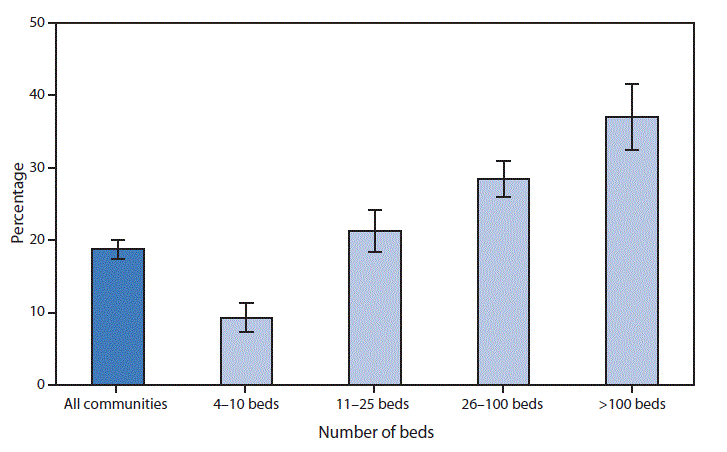QuickStats: Percentage of Residential Care Communities* Using Electronic Health Records,†§ by Number of Beds — National Study of Long-Term Care Providers, United States, 2014

* Residential care communities refer to assisted living and similar residential places (e.g., personal care homes, board and care homes, homes for the aged, and housing with service establishments). Nursing homes and those with missing data were excluded.
† Respondents were asked, "An electronic health record is a computerized version of the resident's health and personal information used in the management of the resident's health care. Other than for accounting or billing purposes, does this residential care community use electronic health records?"
§ With 95% confidence intervals.
In 2014, 19% of residential care communities used electronic health records (EHRs). The larger communities were more likely to use EHRs. The percentage of communities with >100 beds using EHRs (37%) was four times the percentage of communities with four to 10 beds (9%).
Source: National Study of Long-Term Care Providers, 2014. Available at http://www.cdc.gov/nchs/nsltcp.htm.
Reported by: Eunice Park-Lee, PhD, hta8@cdc.gov, 301-458-4506; Vincent Rome, MPH; Christine Caffrey, PhD; Lauren Harris-Kojetin, PhD.
Alternate Text: The figure above is a bar chart showing that in 2014, 19% of residential care communities used electronic health records (EHRs). The larger communities were more likely to use EHRs. The percentage of communities with >100 beds using EHRs (37%) was four times the percentage of communities with four to 10 beds (9%).
Use of trade names and commercial sources is for identification only and does not imply endorsement by the U.S. Department of
Health and Human Services.
References to non-CDC sites on the Internet are
provided as a service to MMWR readers and do not constitute or imply
endorsement of these organizations or their programs by CDC or the U.S.
Department of Health and Human Services. CDC is not responsible for the content
of pages found at these sites. URL addresses listed in MMWR were current as of
the date of publication.
All MMWR HTML versions of articles are electronic conversions from typeset documents.
This conversion might result in character translation or format errors in the HTML version.
Users are referred to the electronic PDF version (http://www.cdc.gov/mmwr)
and/or the original MMWR paper copy for printable versions of official text, figures, and tables.
An original paper copy of this issue can be obtained from the Superintendent of Documents, U.S.
Government Printing Office (GPO), Washington, DC 20402-9371;
telephone: (202) 512-1800. Contact GPO for current prices.
**Questions or messages regarding errors in formatting should be addressed to
mmwrq@cdc.gov.


